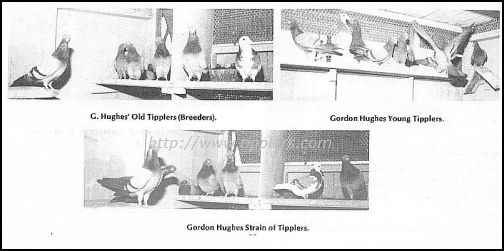david fuller / 12 Nov 2011 12:26

A copy of my breeding chart covering 25 years of breeding wherein I produced
my own strain of tipplers. Of course, I bred very many more birds than those
shown which mostly flew very well, and I have of course supplied fanciers
throughout the world with good birds. However, I have only shown on the
chart the ones I used for stock. All the birds shown were produced from
two-half brothers . . Cock 1953/156 and Cock 1954/9. Both these cocks as you
will see were produced from Hen 1949/4190. The hen 1949/2360 was introduced
to the two half brothers and these three birds were inbred over the years
1953 to1978 to produce kits which flew consistently year after year for 19
hours as old birds and 16 to 18 hours as youngsters. The chart is a little
awkward to read, but if you take one bird at a time and follow its' breeding
through the years, it will become more understandable. You will see that the
hen 1955/1169 won the National Tippler Union's Long Day Competition in 1956.
She flew together with her nestmate and a halfsister not shown on the chart.
Then at the other end of the chart 1973/153 and 1975/146 flew 18 hours and 7
minutes on July 1,1973 which is the Young Bird World Record.
I did not breed to any particular pattern except that I always bred with the
strongest birds and never paired brother and sister together. However, I did
try this on some occasions but found that the youngsters were no better than
birds bred from parents less closely related. Over the years I did
experiment with other strains (always hens) bred into mine but I always
reverted back to my own pure strain as I could never find a cross which made
my own birds better competitors. However, in 1973, I was sent a bird by a
friend who lived in Wales. Thiswasa badge (blue and white) hen. I paired
this to cock 1972/173 and a young hen from this pairing was in the kit which
flew 18:07 (Young Bird World Record) as a youngster. She later flew over 19
hours twice. I paired this young hen back in again to my strain to cock
1972/162 in 1977 and this pairing, the youngsters of which were now 3A from
my pure cocks and V4 from the badge strain produced the three birds which
flew 20 hours and three minutes in 1978.
You will see from these pairings that a good hen put into a strong inbred
strain will do no harm and after three generations of pairings only the
young hens from the cross up to the cocks of the inbred strain, the
youngsters are almost indecernable from the inbred strain. All the cocks
which did not take after my own strain, which were produced from the cross
were disposed of, except for one which was of the third generation of
crossing and this bird was a exceptional likeness of my own strain. He was
in the kit which flew 20 hours and 3 minutes in 1978.
I am 59 years of age now and have kept tipplers for 54 years and have met
some very good friends. I have spent more time training birds in darkness
than daylight and have very often stayed at the top of the garden until
daybreak to get the last bird of a kit. Only an absolutely dedicated person
would dream of going to such lengths.
My greatest disappointment was during 1978 when I broke the all time
National record at Easter when my kit did approximately 18 hours but were
disgualified as the referee could not see them within the period allowed by
the rules. When I put my lights on, I had the kit in the loft within five
minutes. They flew perfectly and came down perfectly just as they had done
in training but all to no avial. My ill fortune continued as in the next
competition during May 1978, I was again disgualified. My kit were still
flying tight together at 19 hours and 15 minutes. They split at 19 hours and
20 minutes. I put my lights on at 19 hours and 25 minutes in order to break
the all time record, but failed to get the third bird of the kit into the
loft in the one hour allowed from the time the kit were seen to be split.
During the latter end of 1978, I decided to take up racing pigeons. I have
been intending to do this for some years. However, I also intended to keep a
few tipplers and keep in touch with the sport, but recently I have sold the
last tippler and have now fifty racing pigeons only. I am afraid that the
Flying Tippler Sport is slowly dying in Great Britain due, I believe, to the
lack of up and coming dedicated fanciers to the sport and the inefficiency
of those now engaged in the sport to encourage new fanciers. My whole
purpose in life has been to make the sport more enjoyable and more
efficient. In doing this, I have spent many hours writing articles and
visiting other fanciers' lofts, but I am of the opinion most of my time has
been wasted as the sport seems to have depreciated in most ways during the
last thirty years.
However, my best wishes to you all in the U.S.A. and perhaps you may be able
to take over as number one country in the Flying Tippler Sport.

Submitted by david fuller on 11/12/2011 12:31:26 PM


